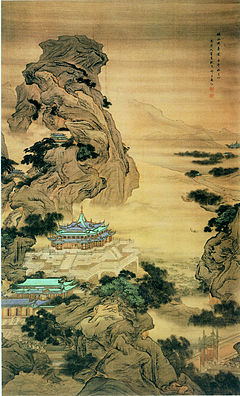- Mount Li
-
Coordinates: 34°21′31.27″N 109°12′37.75″E / 34.3586861°N 109.2104861°E
 Mount Li Escaping the Heat, hanging scroll, color on silk (Yuan Jiang 1644–1912)
Mount Li Escaping the Heat, hanging scroll, color on silk (Yuan Jiang 1644–1912)
Mount Li (simplified Chinese: 骊山; traditional Chinese: 驪山; pinyin: Lí Shān) is a mountain located in the northwest of Xi'an in Shaanxi Province, China.[1] The mountain is part of the Qinling mountain range and rises to a height of 1302 metres above sea level. It is one of the eight scenic spots of the Guanzhong Plain and popularly said to "shine like a beacon in the evening sunlight".
Contents
History
Some ancient tales say that the literal Chinese name "Black Steed Mountain" stems from its resemblance to a horse whilst others that the name arose during the Shang and Zhou Dynasties because the "Black Steed Tribe", lived in this area. Another legend cites the mountain as the place from where the goddess Nüwa, creator of mankind, repaired the wall of heaven.
Huaqing Pool, a Tang Dynasty hot spring complex, stands at the foot of Mount Li.
Republic of China era
In 1936, Kuomintang (KMT) leader Chiang Kai-shek arrived in Shaanxi Province and stayed at Huaqinqi. His ostensible mission was to eradicate the local Communists and warlords but instead he was kidnapped whilst hiding in a crevice on Li Mountain in what became known as the Xi'an Incident. After the incident, the KMT government built the simple "Minzu Fuxing Pavilion" (民族复兴亭) at the foot of the crevice in commemoration.
The building was reconstructed using steel and concrete in 1946 with the relevant funds subscribed by students of the Whampoa Military Academy in Guangdong. It was renamed the "Zhengqi Pavilion" (正气亭) with inscriptions in the building eulogizing Chiang authored by senior KMT officers.
People's Republic of China era
After the 1949 Communist victory, the pavilion was for a time called the "Seizing Chiang Pavilion" (捉蒋亭), finally adopting its current name of "Bingjian Pavilion" (兵谏亭; literally "stern advice backed by force") in 1986. Both terms refer to the Xi'an Incident.
Today, Li Mountain National Forest Park is a national level protected site and an AAAA rated tourist attraction classified as a cultural and historic monument.
References
This article is based on a translation of 骊山 in Chinese Wikipedia
External links
National parks of China Beidaihe • Benxi Shuidong National Park • Mount Cangyan • Chengde Mountain Resort • Dian Lake • Dujiangyan Irrigation System • Mount Emei • Fuxian Lake • Mount Heng (Hunan) • Mount Heng (Shanxi) • Hexigten Global Geopark • Mount Hua • Huangguoshu Waterfall • Huanglong, Sichuan • Mount Huang • Jade Dragon Snow Mountain • Jinggangshan Mountains • Jiuzhaigou Valley • Mount Lao • Mount Li • Longmen Grottoes • Mount Luofu • Mount Lu • Lushan Quaternary Glaciation National Geopark • Mount Jiuhua • Mount Mogan • Pearl Shoal Waterfall • Pudacuo National Park • Mount Putuo • Qianshan National Park • Mount Qingcheng • Qinghai Lake • Mount Qingyuan • Mount Qiyun • Mount Sanqing • Sanshan Islands • Shilin (Stone Forest) • Mount Song • Taihu Lake • Mount Tai • Mount Tianzhu • Wudang Mountains • Wulingyuan • Mount Wutai • Wuyi Mountains • Xixi National Wetland Park • Yuelu Mountain • Yun Mountain • Zhangjiajie National Forest Park • Wangwushan - Yuntaishan National Park •Categories:- Mountains of China
- National parks of China
- Geography of Shaanxi
- History of Shaanxi
Wikimedia Foundation. 2010.
